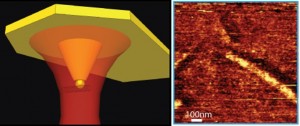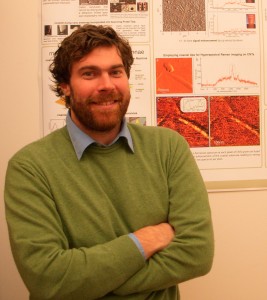
Schematic of coaxial probe for imaging a carbon nanotube (left) and chemical map of carbon nanotube with chemical and (right) topographical information at each pixel. (Image from Weber, et. al)
A pixel is worth a thousand words? Not exactly how the saying goes, but in this case, it holds true: scientists at Berkeley Lab’s Molecular Foundry have pioneered a new chemical mapping method that provides unprecedented insight into materials at the nanoscale. Moving beyond traditional static imaging techniques, which provide a snapshot in time, these new maps will guide researchers in deciphering molecular chemistry and interactions at the nanoscale—critical for artificial photosynthesis, biofuels production and light-harvesting applications such as solar cells.
“This new technique allows us to capture very high-resolution images of nanomaterials with a huge amount of physical and chemical information at each pixel,” says Alexander Weber-Bargioni, a postdoctoral scholar in the Imaging and Manipulation of Nanostructures Facility at the Foundry. “Usually when you take an image, you just get a picture of what this material looks like, but nothing more. With our method, we can now gain information about the functionality of a nanostructure with rich detail.”
The Molecular Foundry is a U.S. Department of Energy (DOE) Office of Science nanoscience center and national user facility. With the Foundry’s state-of-the-art focused ion beam tool at their disposal, Weber-Bargioni and his team designed and fabricated a coaxial antenna capable of focusing light at the nanoscale, – a harnessing of light akin to wielding a sharp knife in a thunderstorm, Weber-Bargioni says.

Molecular Foundry postdoctoral scholar Alex Weber-Bargioni and colleagues have pioneered a new imaging capability for chemical mapping of nanoscale materials.
Consisting of gold wrapped around a silicon nitride atomic force microscope tip, this coaxial antenna serves as an optical probe for structures with nanometer resolution for several hours at a time. What’s more, unlike other scanning probe tips, it provides enough enhancement, or light intensity, to report the chemical fingerprint at each pixel while collecting an image (typically 256 x 256 pixels). This data is then used to generate multiple composition-related “maps,” each with a wealth of chemical information at every pixel, at a resolution of just twenty nanometers. The maps provide information that is critical for examining nanomaterials, in which local surface chemistry and interfaces dominate behavior.
“Fabricating reproducible near-field optical microscopy probes has always been a challenge,” says Frank Ogletree, acting Facility Director of the Imaging and Manipulation of Nanostructures Facility at the Foundry. “We now have a high-yield method to make engineered plasmonic probes for spectroscopy on a variety of surfaces.”
To test out the capability of their new probe, the team examined carbon nanotubes, sheets of carbon atoms rolled tightly into tubes just a few nanometers in diameter. Carbon nanotubes are ideal for this type of interactive investigation as their unmatched electronic and structural properties are sensitive to localized chemical changes.
Users coming to the Molecular Foundry to seek information about light-harvesting materials or any dynamic system should benefit from this imaging system, Weber-Bargioni says.
Adds Jim Schuck, staff scientist in the Imaging and Manipulation of Nanostructures Facility at the Foundry, “We’re very excited—this new nano-optics capability enables us to explore previously inaccessible properties within nanosystems. The work reflects a major strength of the Molecular Foundry, where collaboration between scientists with complementary expertise leads to real nanoscience breakthroughs.”
A paper reporting this research titled, “Hyperspectral nanoscale imaging on dielectric substrates with coaxial optical antenna scan probes,” appears in Nano Letters and is available to subscribers online. Co-authoring the paper with Weber-Bargioni, Ogletree and Schuck were Adam Schwartzberg, Matteo Cornaglia, Ariel Ismach, Jeffrey Urban, Yuanjie Pang, Reuven Gordon, Jeffrey Bokor, Miquel Salmeron, Paul Ashby and Stefano Cabrini.
This work at the Molecular Foundry was supported by DOE’s Office of Science.
The Molecular Foundry is one of the five DOE Nanoscale Science Research Centers (NSRCs), national user facilities for interdisciplinary research at the nanoscale, supported by the DOE Office of Science. Together the NSRCs comprise a suite of complementary facilities that provide researchers with state-of-the-art capabilities to fabricate, process, characterize and model nanoscale materials, and constitute the largest infrastructure investment of the National Nanotechnology Initiative. The NSRCs are located at DOE’s Argonne, Brookhaven, Lawrence Berkeley, Oak Ridge and Sandia and Los Alamos National Laboratories. For more information about the DOE NSRCs, please visit http://nano.energy.gov.
Lawrence Berkeley National Laboratory is a U.S. Department of Energy (DOE) national laboratory managed by the University of California for the DOE Office of Science. Berkeley Lab provides solutions to the world’s most urgent scientific challenges including sustainable energy, climate change, human health, and a better understanding of matter and force in the universe. It is a world leader in improving our lives through team science, advanced computing, and innovative technology. Visit our Website at www.lbl.gov
Additional Information
For more information about the Molecular Foundry vist the Website at http://foundry.lbl.gov/